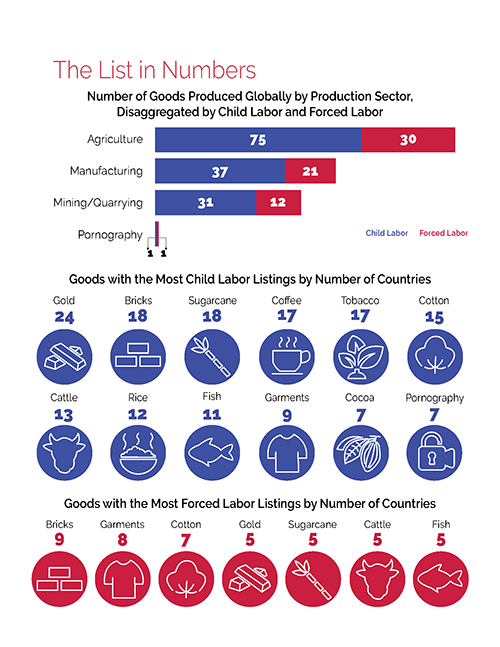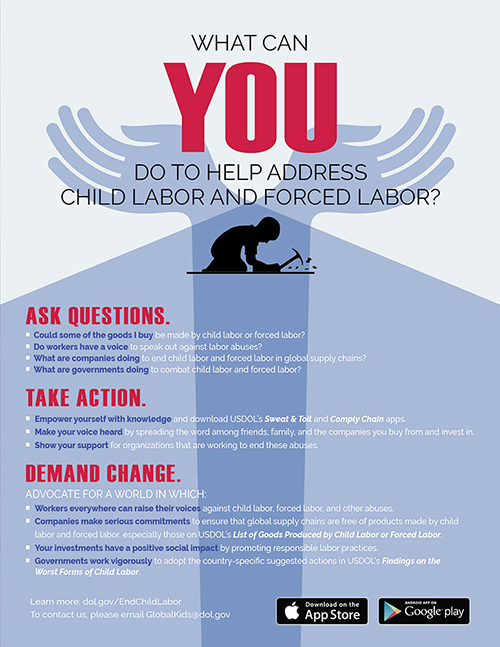List of Goods Produced by Child Labor or Forced Labor
The Bureau of International Labor Affairs (ILAB) maintains a list of goods and their source countries which it has reason to believe are produced by child labor or forced labor in violation of international standards, as required under the Trafficking Victims Protection Reauthorization Act (TVPRA) of 2005 and subsequent reauthorizations. The List of Goods Produced by Child Labor or Forced Labor comprises 159 goods from 78 countries and areas, as of September 28, 2022.
ILAB maintains the List primarily to raise public awareness about forced labor and child labor around the world and to promote efforts to combat them; it is not intended to be punitive, but rather to serve as a catalyst for more strategic and focused coordination and collaboration among those working to address these problems.
Publication of the List has resulted in new opportunities for ILAB to engage with foreign governments to combat forced labor and child labor. It is also a valuable resource for researchers, advocacy organizations and companies wishing to carry out risk assessments and engage in due diligence on labor rights in their supply chains.
The countries on the List span every region of the world. The most common agricultural goods listed are sugarcane, cotton, coffee, tobacco, cattle, rice, and fish. In the manufacturing sector, bricks, garments, textiles, footwear, carpets, and fireworks appear most frequently. In mined or quarried goods, gold, coal and diamonds are most common.
ILAB published the initial TVPRA List in 2009 and updated it annually through 2014, following a set of procedural guidelines that were the product of an intensive public consultation process. ILAB now updates and publishes the List every other year, pursuant to changes in the law.
Procedural Guidelines
On January 25, 2024, ILAB's Office of Child Labor, Forced Labor, and Human Trafficking published Procedural Guidelines for the development and maintenance of the List of Goods from countries produced by child labor or forced labor in violation of international standards.
| Country/Area | Good | Exploitation Type |
|---|---|---|
| Thailand | Forced Labor | |
| Thailand | There are reports that mostly girls as young as 11 are forced to produce garments in Thailand. Migrant children from Laos and Burma are particularly vulnerable. The ILO, media, trade unions, government raids, and NGOs report forced child labor in garment factories in Bangkok and along the Burma border in Mae Sai and Mae Sot. Many children live at the worksite, and their freedom of movement is sometimes restricted through confiscation of identity documents and threats of arrest. Children are often forced to work long hours and overtime, and are paid little, if at all. Some are not provided sufficient food and are physically abused. Mistakes made during the course of work are sometimes penalized with wage deductions. |
Child Labor, Forced Labor |
| Thailand | Child Labor | |
| Thailand | There are reports that children are forced to process shrimp in Thailand. Burmese and Cambodian immigrants are particularly vulnerable to forced child labor in the shrimp industry. A UN report identified approximately 150 children working, many alongside their mothers, in Klong Yai district near the Cambodia border. Children are often forced to peel and sort shrimp. Some are forced to work long hours without breaks, physically abused, and prohibited from leaving the worksite. They frequently have their identity documents confiscated by their employers. In some cases, child workers are paid little, if at all, and their wages are deducted to repay debts related to recruitment, food, and/or lodging. The children often endure these conditions under the threat of dismissal and arrest by immigration police.
|
Child Labor, Forced Labor |
| Thailand | Child Labor |
your hand? Download ILAB's Sweat & Toil App today!
Are you a company looking to fight child labor and forced labor in supply
chains?





